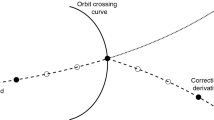Abstract
The present paper reviews the Nekhoroshev theorem from the point of view of physicists and astronomers. We point out that Nekhoroshev result is strictly connected with the existence of a specific structure of the phase space, the existence of which can be checked with several numerical tools. This is true also for a degenerate system such as the one describing the motion of an asteroid in the so called main belt. The main difference is that in some parts of the belt, the Nekhoroshev result cannot apply a priori. Mean motion resonances of order smaller than the logarithm of the mass of Jupiter and first order secular resonances must be excluded. In the remaining parts, conversely, the Nekhoroshev theorem can be proved, provided someparameters, such as the masses, the eccentricities and the inclinations of the planets are small enough. At the light of this result, a massive campaign of numerical integrations of real and fictitious asteroids should allow to understand which is the real dynamical structure of the asteroid belt.
Similar content being viewed by others
References
Arnold, V., I.: 1963, Proof of A. N. Kolmogorov's theorem on the conservation of conditionally periodic motions with a small variation in the Hamiltonian., Russian Math. Surv., 18, No. 5, 9–36.
Benettin, G., Galgani L., and Giorgilli A.: 1985, A proof of Nekhoroshev's theorem for the stability times in nearly integrable Hamiltonian systems., Cel. Mech., 37, 1.
Benettin, G. and Gallavotti G.: 1986, Stability of motions near resonances in quasiintegrable Hamiltonian systems., J. Stat. Phys., 44, 293–338.
Benettin, G., Fassò F. and Guzzo M.: 1996, Fast rotations of the rigid body: a study by Hamiltonian perturbation theory. Part II: gyroscopic rotations., preprint.
Bretagnon, P.: 1974, Termes a longues périodes dans le système solaire., Astron. Astrophys., 30, 141–154.
Chirikov, B. V.; 1979, A universal instability of many dimensional oscillator systems Physics reports, 52, 265–379.
Contopoulos, G.: 1967, in Nahon, F. and Hénon, M. (eds): Les nouvelles methodes de la dynamique stellaire, CNRS, Paris (1966); see also Bull. Astron. Ser. 3, 2, Fasc. 1, 233.
Dermott, F. S. and Murray, C. D.: 1983, Nature of the Kirkwood gaps in the asteroid belt., Nature, 301, 201–205.
Farinella, P., Froeschlé, Ch. Froeschlé, C., Gonczi, R., Hahn, G., Morbidelli, A. and Valsecchi, G. B.: 1994, Asteroids falling onto the Sun, Nature, 371, 315–317.
Froeschlé C.: 1972, Numerical study of a four dimensional mapping, Astron. Astrophys., 16, 172–189.
FroeschIé C. and Lega E.: 1995, On the measure of the stricture around the last KAM toius before and after its break-up, Celest. Mech., in press.
Giorgilli, A. and Morbidelli A.: 1996, Invariant KAM tori and global stability for Hamiltonian systems, ZAMP, in press.
Giorgilli, A. and Skokos C.: 1996, On the stability of the Trojan asteroids, Astron. Astrophys., in press.
Guzzo M. and Morbidelli A.; 1996, Construction of a Nekhoroshev like result for the asteroid belt dynamical system, Celest. Mech., submitted.
Laskar, J.,: 1990, The chaotic motion of the solar system: a numerical estimate of the size of the chaotic zones, Icarus, 88, 266–291.
Laskar J., Froeschlé C. and Celletti A: 1992, The measure of chaos by the numerical analysis of the fundamental frequencies. Application to the standard mapping, Physica D, 56, 253–269.
Laskar, J.: 1993, Frequency analysis for multi-dimensional systems. Global dynamics and diffusion., Physica D, 67, 257–281.
Laskar, J.: 1995, Large scale chaos and marginal stability in the Solar System, XIth ICMP Colloquium, Paris.
Lazutkin, V.F.: 1973, The existence of caustics for a billiard problem in a convex domain, Math. USSR Izis, 7, 185–214.
Lochak, P.: 1992, Canonical perturbation theory via simultaneous approximations, Usp. Math. Nauk., 47, 59–140. English transl in Russ. Math. Surv.
Milani, A., and Knežević, Z.: 1990, Secular perturbation theory and computation of asteroid proper elements., Celest. Mech., 49, 247–411.
Milani A, Nobili A. M. and Knežević Z. 1995, Stable chaos in the asteroid belt, Icarus, submitted.
Morbidelli, A., and Henrard, J.: 1991, Secular resonances in the asteroid belt: theoretical perturbation approach and the problem of their location., Celest. Mech., 51, 131–167.
Morbidelli, A., Gonczi, R., Froeschlé, Ch. and Farinella, P.: 1993, Delivery of meteorites trough the v 6 secular resonance, Astron. Astrophys., 282, 955–979.
Morbidelli, A., and Giorgilli, A.: 1995, On a connection between KAM and Nekhoroshev theorems, Physica D, 86, 514–516.
Moons, M. and Morbidelli, A.: 1995, Secular resonances inside mean-motion commensurabilities: the 4/1, 3/1, 5/2 and 7/3 cases., Icarus, 114, 33–50.
Morbidelli, A., Zappalá, V., Moons, M. Cellino, A. and Gonczi, R.: 1995, Asteroid families close to mean motion resonances: dynamical effects and physical implications, Icarus, 118, 132–154.
Morbidelli A., and Froeschlé C.: 1996, On the relationship between Lyapunov times and macroscopic instability times Celest. Mech., 63, 227–239.
Morbidelli A. and Giorgilli A.: 1996. On the role of high order resonances in normal forms and in separatrix splitting, Physica D, 1454, 1–13.
Neishtadt, A. I.: 1984, The separation of motions in systems with rapidly rotating phase, Prikl. Matem. Mekan. 48:2, 197–204; english transl. Appl. Math. Mech. 48:2, 133–139 (1984).
Nekhoroshev, N., N.: 1977, Exponential estimates of the stability time of nearintegrable Hamiltonian systems., Russ. Math. Surveys, 32, 1–65.
Nekhoroshev, N., N.: 1979, Exponential estimates of the stability time of nearintegrable Hamiltonian systems, 2., Trudy Sem. Petrovs., 5, 5–50.
Pöschel, J.: 1993, Nekhoroshev's estimates for quasi-convex Hamiltonian systems, Math. Z., 213, 187.
Poincaré, H.: 1892, Les Méthodes Nouvelles de la Mécanique Céleste, Gauthier-Villars, Paris.
Tisserand, M. F.: 1882, Ann. Obs. Paris, 16, E1.
Williams, J. G.: 1969, Secular perturbations in the solar system., Ph.D. dissertation, University of California, Los Angeles.
Wisdom J.: 1980, The resonance overlap criterion and the onset of stochastic behavior in the restricted three body problem, AJ, 85, 1122–1133.
Author information
Authors and Affiliations
Rights and permissions
About this article
Cite this article
Morbidelli, A., Guzzo, M. The nekhoroshev theorem and the asteroid belt dynamical system. Celestial Mech Dyn Astr 65, 107–136 (1996). https://doi.org/10.1007/BF00048442
Issue Date:
DOI: https://doi.org/10.1007/BF00048442




